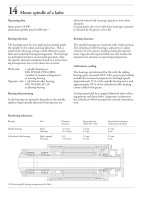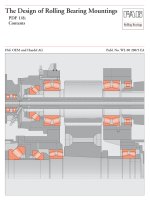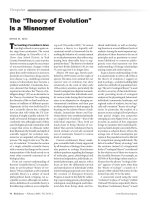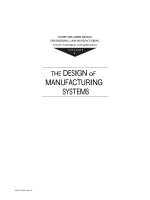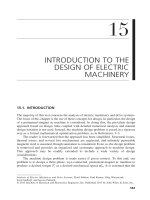A072 the design of prestress concrete bridges
Bạn đang xem bản rút gọn của tài liệu. Xem và tải ngay bản đầy đủ của tài liệu tại đây (14.82 MB, 606 trang )
The Design of Prestressed
Concrete Bridges
Also available from Taylor & Francis
Reynolds’s Reinforced Concrete Designer’s Handbook, 11th edn
C. Reynolds et al.
Hb: 978-0-419-25820-9
Pb: 978-0-419-25830-8
Wind Loading of Structures, 2nd edn
J. Holmes
Hb: 978-0-415-40946-9
Concrete Bridges
P. Mondorf
Hb: 978-0-415-39362-1
Bridge Loads
C. O’Connor et al.
Hb: 978-0-419-24600-8
Concrete Mix Design, Quality Control and Specification, 3rd edn
K. Day
Hb: 978-0-415-39313-3
Examples in Structural Analysis
W. McKenzie
Hb: 978-0-415-37053-0
Pb: 978-0-415-37054-7
Reinforced Concrete, 3rd edn
P. Bhatt et al.
Hb: 978-0-415-30795-6
Pb: 978-0-415-30796-3
Information and ordering details:
For price, availability and ordering visit our website www.tandf.co.uk/builtenvironment
Alternatively our books are available from all good bookshops.
The Design of Prestressed
Concrete Bridges
Concepts and principles
Robert Benaim
First published 2008
By Taylor & Francis
2 Park Square, Milton Park, Abingdon, Oxon OX14 4RN
Simultaneously published in the USA and Canada
By Taylor & Francis
270 Madison Avenue, New York, NY 10016
Taylor & Francis is an imprint of the Taylor & Francis Group, an informa
business
This edition published in the Taylor & Francis e-Library, 2007.
“To purchase your own copy of this or any of Taylor & Francis or Routledge’s
collection of thousands of eBooks please go to www.eBookstore.tandf.co.uk.”
© 2008 Robert Benaim
All rights reserved. No part of this book may be reprinted or reproduced or
utilised in any form or by any electronic, mechanical, or other means, now
known or hereafter invented, including photocopying and recording, or in
any information storage or retrieval system, without permission in writing
from the publishers.
The publisher makes no representation, express or implied, with regard to
the accuracy of the information contained in this book and cannot accept
any legal responsibility or liability for any efforts or omissions that may be
made.
British Library Cataloguing in Publication Data
A catalogue record for this book is available from the British Library
Library of Congress Cataloging-in-Publication Data
Benaim, Robert.
The design of prestressed concrete bridges : concepts and principles /
Robert Benaim.
p. cm.
Includes bibliographical references and index.
1. Bridges, Concrete–Design and construction. 2. Reinforced concrete
construction. I. Title.
TG340.B3975 2007
624.2–dc22
2007004615
ISBN 0-203-96205-2 Master e-book ISBN
ISBN10: 0–415–23599–5 (hbk)
ISBN10: 0–203–96205–2 (ebk)
ISBN13: 978–0–415–23599–0 (hbk)
ISBN13: 978–0–203–96205–3 (ebk)
I would like to dedicate this book to my wife Simone who has supported me in all the
phases of my professional life, from the initial decision to take the risk of starting my
own practice, through the tensions and crises that are an integral part of the major
international projects in which we were involved, to the long drawn out preparation
of this book.
Contents
Figures
Acknowledgements
Disclaimer
xiii
xxii
xxiii
Introduction
1
1 The nature of design
1.1 Design and analysis
1.2 A personal view of the design process
1.3 Teamwork in design
1.4 The specialisation of designers
1.5 Qualities required by a bridge designer
1.6 Economy and beauty in design
1.7 Expressive design
1.8 Bridges as sculpture
1.9 Engineering as an art form
4
4
5
6
7
8
9
14
19
23
2 Basic concepts
2.1 Introduction
2.2 Units
2.3 Loads on bridge decks
2.4 Bending moments, shear force and torque
2.5 Limit states
2.6 Statical determinacy and indeterminacy
28
28
28
29
32
33
3 Reinforced concrete
3.1 General
3.2 The historical development of reinforced concrete
3.3 General principles of reinforced concrete
3.4 Reinforced concrete in bending
3.5 The cracking of reinforced concrete
3.6 The exothermic reaction
35
35
37
40
47
51
28
35
viii
Contents
3.7
3.8
3.9
3.10
3.11
3.12
The ductility of reinforced concrete
Imposed loads and imposed deflections
Creep and relaxation of concrete
Truss analogy
Strut-and-tie analogy
Continuity between the concepts of bending and arching
action
4 Prestressed concrete
4.1 Introduction
4.2 A comparison between reinforced concrete and prestressed
concrete
4.3 Pre-tensioning and post-tensioning
4.4 Conclusion
5 Prestressing for statically determinate beams
5.1 General
5.2 Materials employed for the example
5.3 Section properties
5.4 Central kern and section efficiency
5.5 Loads
5.6 Bending moments, bending stresses and shear force
5.7 Centre of pressure
5.8 Calculation of the prestress force
5.9 Table of stresses
5.10 Non-zero stress limits
5.11 Compressive stress limits
5.12 Sign convention
5.13 Arrangement of tendons at mid-span
5.14 Cable zone
5.15 The technology of prestressing
5.16 Cable profile
5.17 Losses of prestress
5.18 The concept of equivalent load
5.19 Internal and external loads
5.20 Prestress effect on shear force
5.21 Anchoring the shear force
5.22 Deflections
5.23 The shortening of prestressed members
5.24 Forces applied by prestress anchorages
5.25 Following steel
5.26 The introduction of prestress forces
5.27 Bonded and unbonded cables
57
58
60
61
70
77
80
80
84
89
90
91
91
91
91
93
95
95
96
97
100
101
102
103
103
104
107
111
116
120
125
125
126
126
128
129
135
137
137
Contents ix
6 Prestressing for continuous beams
6.1 General
6.2 The nature of prestress parasitic moments
6.3 Parasitic moments at the ULS
6.4 The effect of parasitic moments on the beam reactions
6.5 Concordant cables
6.6 Straight cables in built-in beams
6.7 Cable transformations
6.8 Control of prestress parasitic moments
6.9 Details of the sample bridge deck
6.10 Section properties
6.11 Comment on the accuracy of calculations
6.12 Dead and live loads
6.13 Bending moments
6.14 Considerations on the choice of tendon size
6.15 Calculating the prestress force
6.16 Prestress scheme 1
6.17 Prestress scheme 2
6.18 Non-zero stress limits
6.19 Very eccentric cross sections
6.20 Design of the parasitic moments
6.21 Modification of bending moments due to creep
6.22 Modification of bending stresses due to creep following
change of cross section
6.23 Bursting out of tendons
6.24 The anchorage of tendons in blisters
6.25 Checks at the ULS
139
139
139
142
143
144
144
145
145
146
147
149
150
150
164
165
167
174
175
177
177
179
7 Articulation of bridges and the design of substructure
7.1 General
7.2 Design parameters
7.3 Bearings: general design considerations
7.4 Mechanical bearings
7.5 Elastomeric bearings
7.6 Concrete hinges
7.7 Design of foundations
7.8 The design of piers
7.9 The articulation of decks with mechanical bearings
7.10 Deck on laminated rubber bearings
7.11 Piers built into the deck
7.12 Split piers
7.13 Integral bridges
7.14 Continuity versus statical determinacy
7.15 Examples of bridge articulation
191
191
191
194
194
197
198
199
208
212
222
223
223
226
227
231
184
185
187
187
x Contents
8 The general principles of concrete deck design
8.1 General
8.2 Transverse bending
8.3 Transverse distribution of live loads
8.4 Material quantities and costs
8.5 Choice of most economical span
238
238
238
240
243
248
9 The design of bridge deck components
9.1 General
9.2 Side cantilevers
9.3 Top slabs
9.4 Bottom slabs
9.5 Webs
9.6 Diaphragms
9.7 Deck drainage
9.8 Waterproofing
9.10 Expansion joints
250
250
250
264
270
278
294
303
306
307
10 Precast beams
10.1 General
10.2 Standard precast beams
10.3 Customised precast beams
308
308
308
312
11 Solid slabs, voided slabs and multi-cell box girders
11.1 Slab bridges, general
11.2 Reinforced concrete slab bridges
11.3 Prestressed concrete slab bridges
11.4 Solid slab portal bridges
11.5 Voided slabs
11.6 Case history: River Nene Bridge
11.7 Multi-cell box girders
327
327
327
328
333
340
344
346
12 Ribbed slabs
12.1 General
12.2 Behaviour of twin rib decks
12.3 The use of diaphragms
12.4 Proportioning of twin rib decks
12.5 Ribbed slabs and skew bridges
12.6 Heat of hydration effects on twin rib decks
12.7 Prestress layout
12.8 Substructure for twin rib bridges
12.9 Construction technology
12.10 The development of ribbed slabs
349
349
351
355
357
362
362
365
365
365
367
Contents xi
13 Box girders
13.1 General
13.2 Cast-in-situ construction of boxes
13.3 Evolution towards the box form
13.4 Shape and appearance of boxes
13.5 The number of webs per box
13.6 Number of boxes in the deck cross section
369
369
369
371
372
378
379
14 Counter-cast technology for box section decks
14.1 General
14.2 Long line casting
14.3 Short line casting
386
386
387
388
15 The construction of girder bridges
15.1 General
15.2 Cast-in-situ span-by-span construction of continuous beams
15.3 Precast segmental span-by-span erection
15.4 Cast-in-situ balanced cantilever construction
15.5 Precast segmental balanced cantilever construction
15.6 Progressive erection of precast segmental decks
15.7 Construction programme for precast segmental decks
15.8 Incremental launching
15.9 Prefabrication of complete spans
414
414
414
422
428
439
458
459
460
475
16 The effect of scale on the method of construction
16.1 General
16.2 A bridge length of 130 m on four spans
16.3 A bridge length of 130 m on three spans
16.4 The bridge is 500 m long
16.5 A series of short bridges totalling typically 1,000 m
16.6 The bridge is 1,000 m long
16.7 The bridge is 2,000 m long
16.8 The bridge is 10,000 m long
484
484
484
485
487
490
491
492
494
17 The design and construction of arches
17.1 General
17.2 Line of thrust
17.3 Unreinforced concrete and masonry arches
17.4 Flat arches
17.5 Reinforced concrete arches
17.6 Short-span reinforced concrete arches with earth fill
17.7 Longer span reinforced concrete arches supporting bridge
decks
17.8 Construction of arches
498
498
498
501
502
503
504
509
512
xii
Contents
17.9 Progressive collapse of multi-span arch bridges
17.10 Tied arches
18 Cable-supported decks
18.1 General
18.2 Extradosed bridge decks
18.3 Undertrussed bridges
18.4 Cable-stayed bridges
18.5 Stressed ribbon bridges
18.6 Steel cable catenary bridges
18.7 Flat suspension bridges
Appendix
References
Index
516
516
519
519
519
521
522
552
560
561
564
568
572
Figures
1.1
1.2
1.3
1.4
1.5
1.6
1.7
1.8
1.9
1.10
1.11
1.12a
1.12b
1.12c
1.12d
1.13
1.14
1.15
1.16
1.17
1.18
2.1
2.2
2.3
2.4
2.5
3.1
3.2
3.3
3.4
3.5
3.6
3.7
3.8
3.9
Cross sections of slip road merging with main carriageway
10
Options for bridge pier
11
Options for flared column
12
STAR Viaduct: typical pier
13
Byker Viaduct: pier finishes
13
Fish belly beams: simply supported beams of Maracaibo Bridge
15
Beam or arch?
16
Byker Viaduct under construction
16
Ah Kai Sha Bridge towers
17
Alex Fraser Bridge towers
18
Hungerford Footbridge
20
Runnymede Bridge: original Lutyens design
21
Long section of Lutyens bridge
21
New Runnymede Bridge
21
New Runnymede Bridge: load testing the bridge model
22
Hampton Court Bridge by Lutyens
22
Pantheon, Rome
24
Beauvais Cathedral
25
Saltash Bridge by Brunel
26
Palazzetto dello Sport by Nervi
26
Salginatobel Bridge by Maillart
27
Bending moment and shear force on cantilever
30
Rectangular cross section cantilever
31
Section unsymmetrical about a horizontal axis
31
Eccentric load creating torsion
32
Statically determinate and indeterminate beams
33
Hagia Sophia in Constantinople
36
Stress–strain curve for concrete
38
Stress–strain curve for high yield reinforcing steel
40
Beam in bending at working load
41
Beam in bending at the ULS
43
Examples 1 and 2
44
Typical highway tunnel below the water table
49
Jacking head
50
Diagrammatic representation of temperature rise and strength gain
of setting concrete
52
xiv
List of figures
3.10
3.11
3.12
3.13
3.14
3.15
3.16
3.17
3.18
3.19
3.20
3.21
3.22
3.23
3.24
3.25
3.26
3.27
3.28
4.1
4.2
4.3
4.4
4.5
4.6
5.1
5.2
5.3
5.4
5.5
5.6
5.7
5.8
5.9a
5.9b
5.9c
5.9d
5.9e
5.10
5.11
5.12
5.13
5.14
5.15
5.16
5.17
5.18
5.19
Typical heat of hydration cracking of walls
Singapore Central Expressway
Alternative reinforcement of two-way slab with beam strips
Imposed loads and imposed deflections on a cantilever
Creep and relaxation of concrete
Truss analogy for beams
Opening in beam web
Halving joint
Load applied close to support
Curtailment of reinforcement
Hanging steel
Shear fields
Tiered strut-and-tie brackets
Stress diagrams for deep beam
Deep beams
Shear friction
Bond of bars and plates
Arching action in beams
Arching action in reinforced concrete floor
Prestressing of two pinned arch
Greek temple
Plain concrete beam
Centrally prestressed beam
Eccentrically prestressed beam
Tied arch
Statically determinate beam
The central kern
Efficiency of typical deck types
Centre of pressure
Calculation of prestress force using kern and centre of pressure
Arrangement of tendons
Plotting the cable zone
Elevation of cable zone
Typical prestress anchors: CCL slab anchor for 6 strands
Typical prestress anchors: CCL anchor for 19 No 15.7 mm strands
Typical prestress anchors: CCL anchor for 37 No 15.7 mm strands
Typical prestress anchors: bar anchors
Typical prestress anchors: buried dead anchors
Prestressing jack
Cable arrangements
Cables in a typical beam
Eccentricity of cables within their ducts
Arrangement of swept up anchors
Loss of prestress due to friction and anchor set
The concept of equivalent load for a ‘V’ profile cable
Equivalent load for a parabolic cable
Equivalent loads for general case
Equivalent loads; straight cable and deflected neutral axis
54
55
58
59
60
62
64
65
66
67
68
69
70
71
73
74
76
77
79
81
81
82
83
83
85
92
93
94
96
98
104
105
106
107
108
108
109
109
110
112
113
113
114
118
121
122
123
124
List of figures xv
5.20
5.21
5.22
5.23
5.24
5.25
5.26
5.27
5.28
6.1
6.2
6.3
6.4
6.5
6.6
6.7
6.8
6.9
6.10
6.11
6.12
6.13
6.14
6.15
6.16
6.17
6.18
6.19
6.20
6.21
6.22
6.23
6.24
6.25
6.26
6.27
6.28
6.29
6.30
6.31
7.1
7.2
7.3
7.4
7.5
7.6
7.7
Equivalent loads; variable thickness flange
The structure must be free to shorten
Stresses behind a prestress anchor
Post-cracking anchor behaviour
Equilibrium forces for slab loaded at its edges
Equilibrium forces for slab loaded at the centre
Potential web cracking due to prestress shear
Following steel
Dispersal of prestress
The principle of parasitic moments
Reactions due to prestress parasitic moments
Concordant cables
Cable transformations
Typical cable zone
Span arrangement of sample bridge
Deck cross section
Effect on bending stresses of shear lag
River Nene Bridge: differential settlement
Rectangular beam subject to linear temperature gradient
Temperature gradients defined by UK code of practice drawn to same
vertical scale as sample box girder
Temperature stresses in box girder
Bending moments caused by temperature gradients
Zone where bottom fibre is susceptible to cracking
Distortion of box girder
Rounding of support moments
Bending moment diagrams
Prestress parasitic moments, scheme 1
Arrangement of tendons
Plotting the cable zone
Prestress scheme 2
Non-zero stress limits
Typical influence line for parasitic moment
Modification of bending moment due to creep
Free cantilever construction: self-weight effects
Free cantilever construction: prestress effects
Creep due to change in cross section
Forces exerted by curved tendons
Anchorage blisters for tendons
Checks at the ULS
Increase of prestress lever arm at the ULS
Sliding pot bearing
Elastomeric bearing
Design rotations for elastomeric bearings
Concrete hinge
Statically determinate arrangements for driven piles
Triangulated piles
The perils of site investigation
124
128
130
130
133
134
134
136
136
140
143
144
145
146
146
147
148
151
153
155
156
158
159
161
162
163
168
172
173
175
176
178
180
182
183
184
186
188
189
190
195
197
198
199
201
202
204
xvi
List of figures
7.8
7.9
7.10
7.11
7.12
7.13
7.14
7.15
7.16
7.17
7.18
7.19
7.20
7.21
7.22
7.23
7.24
7.25
7.26
8.1
8.2
8.3
8.4
8.5
8.6
8.7
8.8
9.1
9.2
9.3
9.4
9.5
9.6
9.7
9.8
9.9
9.10
9.11
9.12
9.13
9.14
9.15
9.16
9.17
9.18
9.19
9.20
9.21
Bored pile options
Pile bending moment under the effect of a horizontal load
Types of pier
Pier of STAR Viaduct
Flared pier details
Typical articulation with mechanical bearings
Null point
Orientation of bearings for curved decks
Temporary fixity of deck built span-by-span
Use of shock absorbers
Typical example of the use of rubber bearings
Development of twin leaf piers
Buckling of split piers
Areas beneath bending moment diagrams
STAR Viaduct
STAR Viaduct: typical cross section
Byker Viaduct: valley piers
Byker Viaduct
East Moors Viaduct
Variation of bottom flange width with span/depth ratio
Distribution of longitudinal stiffness to provide support for top slab
Alternative deck for the Sungai Kelantan Bridge
Two-beam torsionless deck
Transverse distribution of loads on beam type decks
Single-cell box girder subjected to an eccentric point load
East Moors Viaduct box section
Equivalent thickness of concrete decks for increasing span
Geometry of side cantilevers
East Moors Viaduct: precast verge
Lever arms for prestressed and reinforced solid slabs
Longitudinal moments in cantilever slabs
Transverse slab joint subjected to longitudinal bending moments
Ribbed cantilever slab
Coffered cantilever slab
Propped cantilever slab
STAR Viaduct: elevated station
STAR Viaduct: propped cantilever slabs
STAR Viaduct: stitches between precast segments
Top slab configuration
Strutted top slab
Arching action in slabs
Slab spanning between torsionally unrestrained ribs
Restraint cracking in the top slab of cast-in-situ segments
Bottom slab configuration
Project for bridge with trussed bottom slab
Out-of-plane forces in bottom slab
Bottom slab at pier
Variable-depth deck with inset bearings
207
208
209
210
211
214
217
218
220
221
222
224
225
228
232
233
234
235
236
239
240
241
242
242
243
244
245
252
253
255
256
257
258
259
260
261
261
262
265
266
267
268
269
271
273
274
275
276
List of figures xvii
9.22
9.23
9.24
9.25a
9.25b
9.26
9.27
9.28
9.29
9.30
9.31
9.32
9.33
9.34
9.35
9.36
9.37
9.38
9.39
9.40
9.41
9.42
9.43
9.44
10.1
10.2
10.3
10.4
10.5
10.6
10.7
10.8
10.9
10.10
10.11
10.12
10.13
10.14
10.15
10.16
10.17
10.18
11.1
11.2
11.3
11.4
11.5
Variable-depth deck with narrow pier
Resal effect
Thickness of webs for Tee beams
STAR Viaduct: typical reinforcement cage for precast segment
East Moors Viaduct: failed pour for trial segment
Failed web pour
Thickness of webs for box sections
East Moors Viaduct: face anchors in locally thickened webs
Use of inclined prestress to shorten web thickening
Detailing shear links
Viaduc des Glacières on the A40 motorway, France
Dong Po South Bridge
Dong Po South Bridge: details
Dong Po Bridges: shear force envelope
Dong Po Bridges: details of trussed webs
Trial panel of truss
Diaphragm for box on single bearing
River Lea Viaduct, Stanstead Abbotts Bypass: prestressed diaphragm
Diaphragm action for inset bearings
Diaphragm action for side-sway
Forces applied by inclined webs
Typical diaphragm for box girder
Piped drainage in precast beam deck
Custom-designed gulley in thin cantilever slab
Standard precast beams
Crosshead options for statically determinate beams
Continuity using cast-in-situ cross-heads
River Lea Viaduct, Stanstead Abbotts Bypass: alternative design
Continuity for live loads
Kwai Chung Viaduct
Express Rail Link, Malaysia
Express Rail Link, Malaysia: typical cross section
Transverse deflection of heavily loaded deck
Options for customised precast beams
Arrangement of slab reinforcement for progressively shorter
cast-in-situ section
Concrete geometry and striking of shutters
Sungai Kelantan Bridge
Sungai Kelantan Bridge: casting yard
Sungai Kelantan Bridge: details
GSZ Superhighway, Pearl River Delta Viaducts
GSZ Superhighway, Pearl River Delta Viaducts: deck details
GSZ Superhighway, Pearl River Delta Viaducts: main casting yard
Incorporated crossbeams
Drops and mushroom heads
Canada Water underground station: roof slab carrying bus station
Development of solid slabs
Solid slab portal bridges
276
277
279
281
281
282
283
284
285
286
288
289
290
291
292
293
296
298
299
301
302
302
305
306
309
310
311
311
312
313
315
315
315
317
319
320
321
321
322
323
324
326
329
330
331
333
334
xviii List of figures
11.6
11.7
11.8
11.9
11.10
11.11
11.12
11.13
11.14
11.15
11.16
11.17
11.18
11.19
12.1
12.2
12.3
12.4
12.5
12.6
12.7
12.8
12.9
12.10
12.11
12.12
12.13
12.14
12.15
12.16
12.17
12.18
13.1
13.2
13.3
13.4
13.5
13.6
13.7
13.8
13.9
13.10
Resultant forces on portal foundations
Singapore Central Expressway
Modelling of portal node
Detailing of node
Nodes for prestressed portals
The effect of prestress parasitic moments on portals
Diagram of prestressed roof for Central Station on the Hong
Kong MTR
Skew portals
Voided slab deck
Voided ribbed slab
River Nene Bridge
River Nene Bridge: details
Multi-cell box girder under construction
Multi-cell box with alternative
Doornhoek Bridge, South Africa: typical twin rib bridge
Contract 304 HKMTR: semi-mechanised falsework
Viaduc d’Incarville, Autoroute de Normandie: self-launching rig
Effect of length of load
Rotational restraint of webs by substructure
Typical influence line for share of mid-span sagging bending
moment carried on rib B
Portal resisting horizontal loads
Contract 308 of the HKMTR, Tai Ho Viaduct: twin rib deck
with pier diaphragms
Evolution of twin rib deck with decreasing depth
Viaduc d’Incarville: parallel-sided ribs with mechanically
operated formwork
Torque in ribs due to imbalance in transverse dead load moments
Typical twin rib decks
Effect of skew on decks
Effect of heat of hydration tensile stresses
Twin pile foundation option
Doornhoek Bridge: typical falsework for span-by-span construction
of short bridge
Super Twin Rib project
RVI Interchange, Bangkok: outline project
Alternative positions of construction joint
Casting deck in one pour
River Dee Bridge: effect of side cantilever on the appearance of a
variable depth deck
Variable depth decks
Variable depth with trapezoidal cross section
Bhairab Bridge, Bangladesh
Rectangular haunch on STAR
Rectangular haunch
Typical width of single cell box designed to UK loading
Strategies for wide decks
335
335
336
337
338
338
339
340
342
343
344
345
346
347
350
350
351
352
353
354
355
356
358
359
360
361
363
364
366
366
367
368
370
371
373
374
375
376
377
377
378
380
List of figures xix
13.11
13.12
13.13
14.1
14.2
14.3
14.4
14.5
14.6
14.7
14.8
14.9
14.10
14.11
14.12
14.13
14.14
Dagenham Dock Viaduct: widening at the West Abutment
Dagenham Dock Viaduct: introduction of third box
Typical detail for bifurcation of multiple box section deck
Typical long line casting bed
Typical short line casting cell
STAR: casting cell ready to receive reinforcement cage
STAR: side shutters, stop-end and core shutter beyond
STAR: trolley for casting cell
Combination of plan curvature and crossfall
STAR: permanent and temporary anchorage blisters
STAR: temporary blister cast-on after precasting
STAR: typical segment details
STAR: directional shear keys
AREA contract: washboard shear keys
East Moors Viaduct: reinforcing cage
STAR: detail of prestressing duct
East Moors Viaduct: temporary stressing blister doubling as
lifting point
14.15 STAR: segment handler
14.16 STAR: casting factory and storage
14.17 Weston-super-Mare railway viaduct: segment stacking
14.18 East Moors Viaduct: segment transport by low loader
14.19 STAR: application of resin
14.20 Byker Viaduct: preparing fibreglass steering packs
15.1
Autoroute A8, France: span-by-span construction of box decks
15.2
Cable arrangements for span-by-span construction
15.3
Options for the trailing prestress anchors
15.4
Support of falsework truss for span-by-span construction
15.5
Hong Kong MTR Contract 304: precast end block
15.6
Viaduc d’Incarville: falsework truss being launched
15.7
East Rail Gantry
15.8
Route 3 Gantry
15.9
West Rail, Hong Kong: detail of gantry
15.10 West Rail, Hong Kong: detail of sledges
15.11a Temporary prestressing anchors: River Lea Viaduct, Stanstead Abbotts
Bypass, concrete blocks
15.11b Temporary prestressing anchors: STAR Viaduct, steel shoes
15.12 Differential creep shortening of boxes
15.13 Kwai Tsing Bridge, Hong Kong
15.14 Typical dead load moments in deck fixed to piers
15.15 Travellers for River Dee Bridge, Newport, UK
15.16 Bhairab Bridge, Bangladesh: underslung falsework travellers
15.17 Typical eccentric hammer head and prop
15.18 Construction of end spans
15.19 Typical layout of prestress tendons for cast-in-situ balanced
cantilever decks
15.20 STAR Viaduct: installation of bearings
383
384
385
387
389
390
390
391
393
397
398
399
400
401
402
403
405
406
407
407
408
409
412
415
416
417
418
420
421
422
423
424
424
427
427
428
429
430
431
432
433
436
438
442
xx List of figures
15.21
15.22
15.23
15.24
15.25
15.26
15.27
15.28
15.29
15.30
15.31
15.32
15.33
15.34
15.35
15.36
15.37
15.38
15.39
15.40
15.41
15.42
15.43
15.44
15.45
15.46
15.47
15.48
15.49
15.50
15.51
16.1
16.2
17.1
17.2
17.3
17.4
17.5
17.6
17.7
17.8
East Moors Viaduct: interior of box showing temporary stressing
bars, web thickenings for face anchors and blisters for Stage 2 cables
Typical moments and forces due to temporary prestress
Location of temporary bar anchors
Typical arrangement of temporary prestress
Belfast Cross Harbour Bridges: spans erected on temporary
stressing alone
Typical arrangement of external stressing
Erection of unbalanced end spans
Building the mid-span stitch
Belfast Cross Harbour Bridges: the flexibility of crane erection
Grangetown Viaducts, Cardiff: erection by fixed crane
Byker Viaduct: erection using shear legs
STAR Viaduct: gantry erection
STAR Viaduct: load testing the pier head falsework
Dagenham Dock Viaduct: gantry erection
Byker Viaduct, Newcastle: progressive erection of decks
Self-weight bending moments during launching
Blackwater Viaduct, Ireland
Eccentricity of launch bearings beneath web
Typical arrangement of casting area
First stage prestress two spans long
Launch bearings and pier head
Kap Shui Mun Bridge, Hong Kong: launching of approach span
Forces on pier head
Liu To Bridge, Hong Kong
Poggio Iberna Viaduct, Italy: launching gantry
Poggio Iberna Viaduct, Italy: deck unit on its transporter
GSZ Pearl River Delta Viaduct, PRC: general arrangement of box
deck option
GSZ Pearl River Delta Viaduct, PRC: production line for
prefabrication of one box per day
GSZ Pearl River Delta Viaduct, PRC: operation of launching gantry
GSZ Pearl River Delta Viaduct, PRC: mechanised mould for
complete span
Bangkok Elevated Rapid Transit System: proposed gantry for
erection of 1,500 t decks
Typical alternatives for a variable-depth wide deck subject to UK
loading
Constant depth with strutted cantilevers
Compression, tension and bending
Concept of line of thrust
Masonry arch with external loads
Flat arch
Transition of portal to arch
Byker Tunnel
Byker Tunnel under construction
New Cowdens arch
442
443
444
445
446
447
449
450
452
453
454
455
456
458
459
462
464
465
467
468
469
470
471
475
476
476
478
478
480
481
481
487
489
499
500
501
502
503
504
505
506
List of figures xxi
17.9
17.10
17.11
17.12
17.13
17.14
17.15
17.16
17.17
17.18
17.19
17.20
17.21
18.1
18.2
18.3
18.4
18.5
18.6
18.7
18.8
18.9
18.10
18.11
18.12
18.13
18.14
18.15
18.16
18.17
18.18
18.19
18.20
18.21
18.22
18.23
18.24
18.25
18.26
18.27
18.28
18.29
18.30
A.1
A.2
Comparison of an arch with a conventional bridge
Maryville arch under construction
Bridge on A16, France
Project for Station Viaduct Middlesbrough
Relative stiffness of arch and deck
Benaim entry to the Poole Harbour Crossing competition
Lateral instability of arches
Bridge over Sungai Dinding
Bridge over Sungai Dinding: balanced cantilever construction of arch
Bridge over Sungai Dinding: span-by-span erection of arches
Construction of Krk Bridge
Construction of Yajisha Bridge
Tied arch
Project for Rambler Channel, Hong Kong
Rambler Channel, cross section
Ganter Bridge
Undertrussed deck
Barrios de Luna Bridge
Multi-span cable-stayed bridges
Pont sur l’Elorn
Linkage between tower and deck oscillation
Arrangement of stays
Preliminary scheme for 460 m span cable-stayed bridge
Typical influence lines and bending moment envelope for bridge
shown in Figure 18.10
Transverse structure of deck
Proposed coffered deck
Pont sur l’Elorn: balanced cantilever construction
Anchorage of stays on towers
Sundsvall Bridge project
Pont sur l’Elorn: stay cable erection
Project for Ah Kai Sha Bridge
Ah Kai Sha Bridge: general arrangement
Ah Kai Sha Bridge: details of trussed webs
Ah Kai Sha Bridge: wind tunnel model of towers 550
Self-anchored suspension/cable stayed hybrid
Rio Colorado Bridge, Costa Rica
Redding Bridge
Forces on crosshead over pier
Project for North Woolwich Road Footbridge
North Woolwich Road Footbridge: details
North Woolwich Road Footbridge: early version
Effect of unsymmetrical loading on suspension bridge with cables
curved in plan
Examples of structures which deflect sideways under eccentric loads
Calculation of section properties
Properties of elements
506
507
508
508
510
510
512
513
514
514
514
515
517
520
520
521
522
523
524
525
526
528
531
532
535
536
537
539
541
542
545
546
548
551
552
552
557
558
559
561
562
563
565
566
Acknowledgements
I would like to express my gratitude to all those who have helped me in the production
of this book.
Professional help has been offered above all by Simon Bourne and Mark Raiss, my
former colleagues and now directors of the Benaim Group, who in the midst of very
busy schedules, found time to read attentively many of the chapters, make thoughtful,
constructive comments, and check my mathematics in detail.
In my quest for attributable images I have been dependent on consultants’ and
contractors’ staff searching back in their records for jobs, some of which are thirty
years old, and I would like to thank all those who helped me in this way. In particular I
would like to thank Pauline Shirley of Arup’s library for her patience and helpfulness in
identifying and making available photographs of the Runnymede Bridge and the Byker
Viaduct, among other projects. I would also like to acknowledge the kind assistance of
the librarians of the Institution of Civil Engineers.
As it is hoped that this book will be read by the technically minded who are not
trained as engineers, I am grateful to my son David for his ‘lay’ reading of the early
chapters, and for his constructive and helpful comments.
Disclaimer
One of the benefits of no longer being responsible for running a practice is that I am
free to say what I think about any subject, without having to consider the commercial
consequences. It should be clear that all views expressed in this book are my own, and
do not engage my former practice, the Benaim Group.
